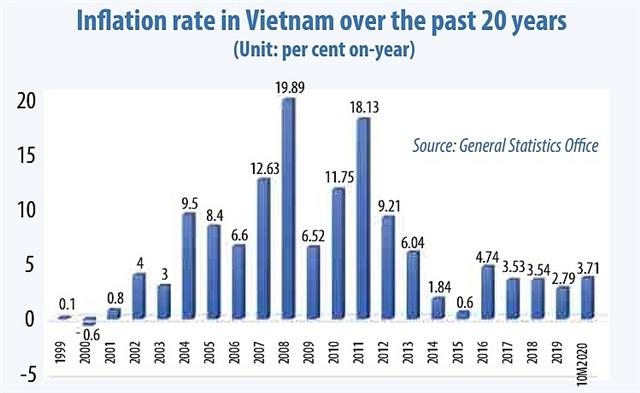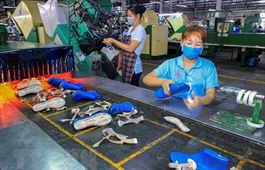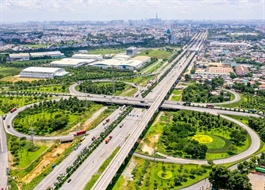Curbed inflation eases concerns
Curbed inflation eases concerns
The big rise in public investment disbursement will not cause high inflation this year due to a decline in public and business demand and oil price, as well as government efforts to stabilise prices.
|
Two weeks ago, Quang Ngai’s government inaugurated Co Luy Bridge, one of the few key state-funded projects helping boost socioeconomic development in the locality.
The 1.9km bridge costs VND2.25 trillion ($97.8 million) coming from government bond issuance and the local budget. It will help the province connect directly with Quang Nam province in the north and Binh Dinh province in the south.
In Hanoi, the Department of Planning and Investment reported that in the first nine months of 2020, the city disbursed over VND19.7 trillion ($856.5 million), hitting 48.5 per cent of the initial plan, up from 34 per cent last year.
Quang Ngai and Hanoi are among the localities boosting public investment disbursement to spur socioeconomic development, and contributing to a rise in this work nationwide. The General Statistics Office (GSO) reported that the economy’s total public investment disbursement in the first 10 months hit VND321.5 trillion ($14 billion), hitting 68.3 per cent of the plan assigned by the government, and up from 49.83 per cent in the corresponding period last year.
According to the GSO, high public investment disbursement will not affect the government’s efforts to control inflation this year.
The consumer price index (CPI) in the first 10 months of this year climbed 3.71 per cent on-year. In which, the building material group’s price, one of the 11 groups of the items used for calculating CPI, rose 2.07 per cent on-year, due to a climb in demand for housing and construction materials, and also pushed up by an increase in public investment.
“Though there has been a strong rise in public investment, it has failed to increase the CPI in the 10 months because of a drop in oil price and public demand, and businesses’ performance remaining weak,” said a GSO expert. “This would also mean that the government will still be able to control the inflation rate at below 4 per cent this year.”
According to the Ministry of Finance (MoF), for 2020 about VND633 trillion ($27.5 billion) worth of public investment must be disbursed. This sum includes VND470.6 trillion ($20.46 billion) assigned for this year and VND162.4 trillion ($7 billion) transferred to 2020 from last year.
The Asian Development Bank (ADB) said inflation in Vietnam may be pushed up by the higher prices for basic commodities and rising liquidity from accelerated public investment. However, it “should nevertheless remain subdued in 2020, well below the 4 per cent central bank target, as weakness in growth and spending persists.”
The ADB explained that lending will likely remain weak despite central bank measures to support it. For their part, banks may be reluctant to relax lending standards to accommodate firms’ weaker balance sheets, fearing an increase in nonperforming loans.
“Credit demand from firms is falling as well, in tandem with weak demand for their products and services. Bank credit is therefore forecast to grow by only 10 per cent this year, well below the central bank’s 14 per cent annual target,” said a recent ADB forecast on Vietnam’s outlook.
Meanwhile, Fitch Solutions, a global provider of data, research and analytics, also stated that inflation in Vietnam should not be a concern for 2020, despite aggressive monetary easing. “We have revised our forecast for inflation to average 3.5 per cent in 2020, down from 3.8 per cent previously, further below the government’s 4 per cent threshold,” said a Fitch Solutions statement sent to VIR.
The inflation in housing and construction materials was mainly due to a rise in electricity and water prices. Fitch Solutions expects easing food supply conditions and discounts offered by restaurants to support businesses to continue cooling inflation in the restaurant and catering segment. That said, a smaller on-year fall in oil prices over the remainder of 2020 will continue to result in lower transport price deflation, putting upside pressure on headline inflation.
“Accordingly, our oil and gas team forecast Brent oil to average $44 per barrel in 2020, down from $64.16 per barrel in 2019, as compared to the year-to-date average of $42.5 per barrel,” said the statement.
PetroVietnam reported that in the first 10 months, its output of some key products saw big on-year reductions, such as crude oil with 9.54 million tonnes, down 14 per cent on-year – including domestically-exploited oil with eight million tonnes, down 14 per cent on-year, and overseas-exploited oil with 1.52 million tonnes, down 11 per cent on-year. PetroVietnam’s exploitation of natural gas hit 7.73 billion cubic metres, down 10 per cent.
Global analysts FocusEconomics also forecast Vietnam’s inflation to stand at over 3 per cent in 2020, and average 3.2 per cent in 2021. For 2022, the panel projects inflation to average 3.9 per cent.
One of the reasons is high unemployment caused by the pandemic causing a drop in demand for goods and services. A joint study by the International Labour Organization and the ADB projects Vietnam to lose 548,000 jobs for young people if the pandemic lasts, and 370,000 jobs even if the outbreak is contained.





















